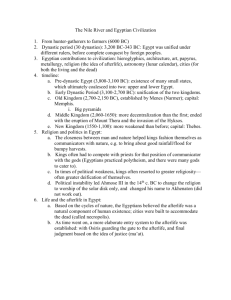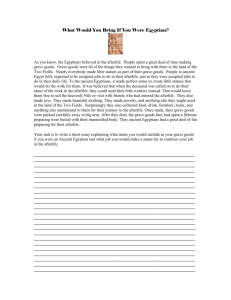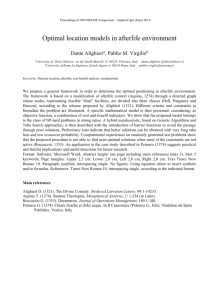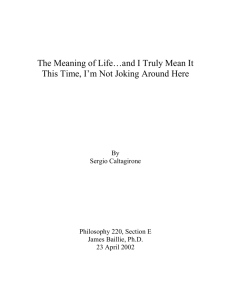Introduction
advertisement
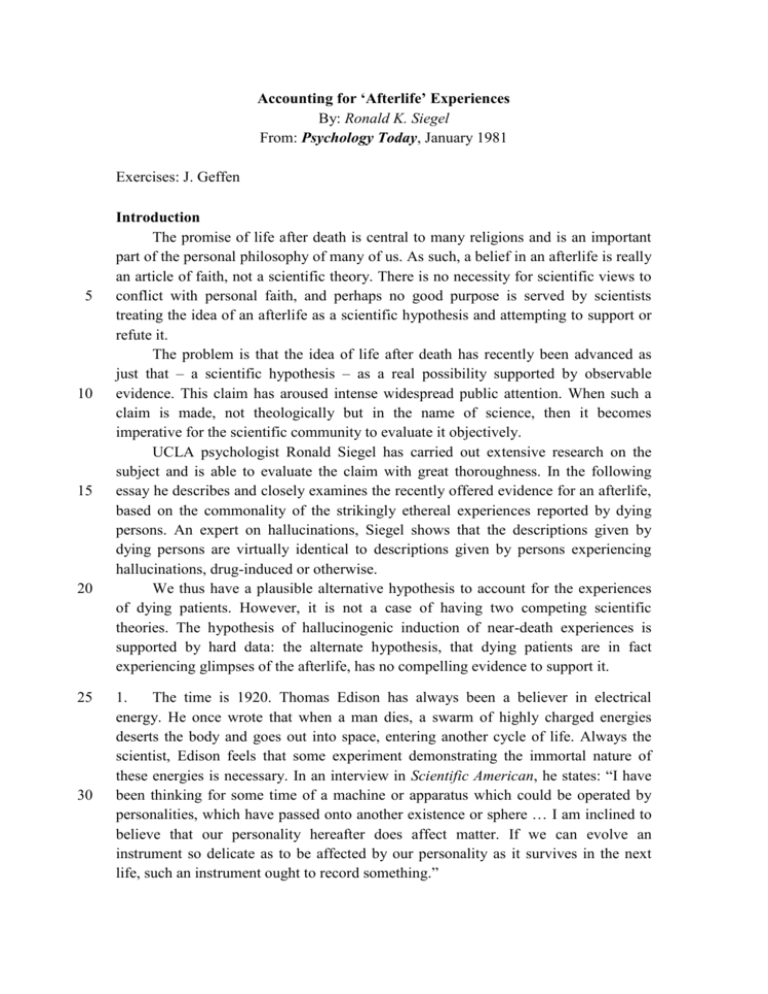
Accounting for ‘Afterlife’ Experiences By: Ronald K. Siegel From: Psychology Today, January 1981 Exercises: J. Geffen 5 10 15 20 25 30 Introduction The promise of life after death is central to many religions and is an important part of the personal philosophy of many of us. As such, a belief in an afterlife is really an article of faith, not a scientific theory. There is no necessity for scientific views to conflict with personal faith, and perhaps no good purpose is served by scientists treating the idea of an afterlife as a scientific hypothesis and attempting to support or refute it. The problem is that the idea of life after death has recently been advanced as just that – a scientific hypothesis – as a real possibility supported by observable evidence. This claim has aroused intense widespread public attention. When such a claim is made, not theologically but in the name of science, then it becomes imperative for the scientific community to evaluate it objectively. UCLA psychologist Ronald Siegel has carried out extensive research on the subject and is able to evaluate the claim with great thoroughness. In the following essay he describes and closely examines the recently offered evidence for an afterlife, based on the commonality of the strikingly ethereal experiences reported by dying persons. An expert on hallucinations, Siegel shows that the descriptions given by dying persons are virtually identical to descriptions given by persons experiencing hallucinations, drug-induced or otherwise. We thus have a plausible alternative hypothesis to account for the experiences of dying patients. However, it is not a case of having two competing scientific theories. The hypothesis of hallucinogenic induction of near-death experiences is supported by hard data: the alternate hypothesis, that dying patients are in fact experiencing glimpses of the afterlife, has no compelling evidence to support it. 1. The time is 1920. Thomas Edison has always been a believer in electrical energy. He once wrote that when a man dies, a swarm of highly charged energies deserts the body and goes out into space, entering another cycle of life. Always the scientist, Edison feels that some experiment demonstrating the immortal nature of these energies is necessary. In an interview in Scientific American, he states: “I have been thinking for some time of a machine or apparatus which could be operated by personalities, which have passed onto another existence or sphere … I am inclined to believe that our personality hereafter does affect matter. If we can evolve an instrument so delicate as to be affected by our personality as it survives in the next life, such an instrument ought to record something.” Accounting for ‘Afterlife’ Experiences / 2 35 40 45 50 55 60 65 70 75 2. The time is 1978. The California Museum of Science and Industry opens an exhibit organized around the thesis that energy is indestructible, that consciousness can exist independently of the physical body, and that there is much evidence that consciousness continues after death. Designated “Continuum,” the exhibit stresses the words of great philosophers who have supported the belief in life after death. Displays bombard the visitor with reports of visions of the dead and descriptions of the afterlife, in order to demonstrate that consciousness can exist without the physical body. However, the exhibit avoids the tricky philosophical problem posed by the fact that a conscious physical body is always the one to make such reports! 3. The belief in life after death thrives. A recent Gallup poll reveals that approximately 70 percent of the people in the United States believe in the hereafter. An earlier survey conducted in the Los Angeles area indicates that 44 percent of the respondents claimed encounters with others known to be dead. 4. Suddenly, popular books abound with stories of reincarnation, mediums, spirits, ghosts, parapsychology, and other evidence for man’s survival after death. Even the speculations of Maurice Maeterlinck on paranormal phenomena – including life after death – are reprinted for popular audiences. 5. Medical journals start publishing reports of patients who have had afterlife visions following near-death experiences. New therapeutic approaches to dying, based on a sympathetic assurance that life continues after bodily death, are developed. A major psychiatric periodical, The Journal of Nervous and Mental Disease, sets a precedent by publishing a literature review of the reincarnation and life-after-death research. Aware of the controversial nature of such a publication, the Journal invites a commentary on the work. Regrettably, the commentary (written by a close friend of Stevenson’s, an admitted “admirer” and colleague of 25 years) is not critical, but heavy with needless platitudes. 6. How should we judge such evidence? Should there be a trial by faith, by fact, or perhaps by combat – reminiscent of holy wars of bygone days? Perhaps a modern jury trial could weigh the evidence. Indeed, such a trial was conducted in 1969 (see The Great Soul Trial, by John Fuller), with the testimony of numerous expert witnesses supporting the belief in survival of the soul after death. The evidence to be presented here can be considered exhibits in a trial for scientific evidence of life after death. The reader, as trier of fact, must resist influence by the passionate and romantic pleadings of highly credentialed “expert” witnesses, since equally qualified experts of opposing viewpoints can always be found. For example, Freud wrote “Our own death is … unimaginable, and whenever we make the attempt to imagine it we can perceive that we really survive as spectators” in the afterlife, and the German poet and scientist Goethe agreed that “the soul is indestructible … its activity will continue through eternity.” Conversely, the equally famous philosopher Auguste Comte replied that “to search for the soul and immortality is a product of a childish phase of human development.” Accounting for ‘Afterlife’ Experiences / 3 80 85 90 95 100 105 110 115 7. Nonetheless, man’s concern with life after death has been more than a passing amusement of childhood. Modern writers who are “pro” life after death are not transparently unscientific in method or data. They acknowledge that their “data” arise spontaneously and are not subject to controlled experiments. They also note that “visits to the other side” can be stimulated by ingestion of hallucinogenic substances, but they curiously discount the possibility of controlled studies with these drugs. Rather, they endorse the use of parapsychological approaches. The bulk of the resultant data consists of phenomenological reports from individuals who have “experienced” life after death. There are a few surveys and questionnaire studies, but many of these are conducted on individuals who only observed dying patients and make inferences as to the nature of deathbed visions of the afterlife. Other studies use highly selective data, although the researchers are honest enough to say so. Betterdocumented studies – of physician Raymond Moody and parapsychologists Karlis Osis and Erlendur Haraldsson – admit that the reported phenomena are open to several interpretations. Most researchers do not appear to be “cranks” who rationalize their interpretations with strong religious convictions, unjust attacks upon opposing viewpoints, or complex neologisms. A rare few compare themselves with Einstein, Columbus, or Galileo in respect to the unconventional investigation of sacred scientific doctrine. But unlike the pseudoscientists described by mathematician Martin Gardner, who manifest strong compulsions to attack the greatest scientists and bestestablished theories, many current investigators of life after death try to accommodate their interpretations to established scientific thinking. These quasi-scientific orientations are all the more deserving of scrutiny because they give the appearance of valid scientific thought and testing. 8. Historian Arnold Toynbee noted in 1975 that all living organisms that are subject to death exert themselves to stay alive, whether or not they have produced progeny. While many species grieve, as humans do, at the loss of mates or members of a social grouping, Toynbee echoes the popular notion that human beings are unique in being aware that death comes to all. Death, in terms of its physical sequels, is no mystery. After death the body disintegrates and is reabsorbed into the inanimate component of the environment. The dead human loses both his life and his consciousness. Toynbee asks the age-old questions of what happens to consciousness after death, since both life and consciousness are invisible and intangible conditions. 9. The most logical guess is that the consciousness shares the same fate as that of the corpse. Surprisingly, this commonsense view is not the prevalent one, and the majority of mankind rejects the hypothesis of annihilation at death. Instead, they continue to exert their basic motivation to stay alive and formulate a myriad of beliefs concerning man’s survival after death. Many of these beliefs revolve around the notion that the intact human personality survives in another dimension – an afterlife. Toynbee finds that idea suspicious, for although the body disintegrates, ghosts and spirits of the dead always appear in the familiar form of an embodied human: Accounting for ‘Afterlife’ Experiences / 4 120 125 130 135 140 145 150 155 “moreover, ghosts appear not naked, but clothed, and this sometimes in the dress of an earlier age than the ghost-seer’s gown… It seems more likely that the apparent visibility of a ghost is an hallucination.” Conversely, Hans Holzer, a contemporary researcher of life after death, believes that the apparitions of the dead wish to be recognized and thus, considerately, appear as they did in physical life. 10. Other versions emphasize reincarnation, whereby humans have many successive lives in this world, each life with a different body, interrupted by short stays in another dimension. This idea of immortality through reincarnation seems to have been suggested to man both by his dreams and by inherited resemblances of the living to the deceased, resemblances in both physical and behavioral traits. Recent LSD research has also suggested that under suitable conditions individuals often have transpersonal experiences in which they experience their own identities but in different times, places, or contexts. These experiences also include distinct feelings of reliving memories of a previous incarnation. However, the allied ability of these LSD subjects to identify with various animals or even inanimate objects strongly suggests that the reincarnation stories are little more than vicariously retrieved memories and fantasies. While some writers, like psychologist William James, have termed such experiences mere “dream creations,” others have given serious philosophical and theological thought to the topic. 11. Since nonhuman animals are governed by physical and biological principles similar to those governing man, the analysis of their behavior associated with dying and death may reveal important insights into related human behaviors. Much of man’s belief in the afterlife is manifested by nonverbal, albeit overt, behaviors. These include religious ritual and ceremony, burying behavior, and the superstitious association of events in nature with ongoing behavioral acts. 12. Anthropologists cite the deliberate interments of the dead by Neanderthal man 100,000 years ago as the first evidence of man’s belief in life after death. Excavations at the famous Shanidar cave in Iraq show evidence of Neanderthal funeral rites, including feasts, burials with flowers and food, and carefully prepared graves with markers. Even the skeletal remains of Cro-Magnon man are found buried in the fetal position, in line with the primitive myth that such a position facilitates rebirth. The study of allied behaviors in non-human animals provides an opportunity to understand their nature and function in man. 13. If deliberate burials are signposts of the belief in life after death for man, one cannot ignore the elaborate burying behavior of elephants as a similar sign of ritualistic or even religious behavior in that species. When encountering dead animals, elephants will often bury them with mud, earth, and leaves. Animals known to have been buried by elephants include rhino, buffalo, cows, calves, and even humans, in addition to elephants themselves. Other ethologists have observed elephants burying their dead with large quantities of food, fruit, flowers and colorful foliage. Not only do these large animals display death rituals, but some of the smallest social insects Accounting for ‘Afterlife’ Experiences / 5 160 165 170 175 180 185 190 195 also display stereotyped patterns of “necrophoric” behavior in regard to corpses. For example, sociobiologist Edward O. Wilson notes that ants of the genus Atta carry their dead into deserted nest chambers and galleries, and that the Strumigenys lopotyle ant of New Guinea “piles fragments of corpses of various kinds of insects in a tight ring around the entrance of its nest in the soil of the rain forest floor.” Other types of funeral rites have been observed among both elephants and chimpanzees in Africa. Ethologist Eugene Marais describes an equally mysterious and quasi-religious behavior among South African baboons; they ritually huddle together with the setting of the sun, gaze at the western horizon, observe a period of silence, and “then from all sides would come the sound of mourning, a sound never uttered otherwise than on occasions of great sorrow – of death or parting.” 14. As do other animals, humans have a strong instinct to survive. Unlike other animals, humans are credited with the capability of realizing that death comes to all. And so, as Richard Cavendish, a historian and folklorist, states: “The human solution to this grim dilemma is a life in some different world after death.” Anthropologists have endorsed this solution, praising man for his “discovery” of the afterlife. Early man’s awareness of his own repeating biological cycles, for example, regeneration of tissue or replacement of baby teeth with permanent teeth, may have provided a basis for this belief. Cavendish credits the belief in an afterlife to man’s cognizance of season cycles, wherein death in winter is followed by rebirth in spring. And man may have been influenced in his observation of other natural cycles: the rising and setting of the sun, day and night, the waxing and waning of the moon, low and high tide, and so on. Indeed, many primitive peoples have religious ceremonies celebrating life after death in close association with natural seasonal events. The Hindus made the direct connection by comparing life after death with the flourishing of this year’s grass and flowers, their dying, and their replacement by similar yet not identical grass and flowers in the next year. Ancient Egyptians believed in eternal life in association with the sun: “the sun rose each day in renewed strength and vigour, and the renewal of youth in a future life was the aim and object of every Egyptian believer.” The sun was the symbol of the afterlife for the Aztecs, who believed that if you died properly, as in battle or sacrifice, you were reborn as a humming bird or butterfly. Among many indigenous groups in South America, the mysterious cyclical appearances of mushrooms following rainstorms were considered gifts from the gods, and the hallucinations resulting from subsequent ingestion of certain species confirmed the reality of an afterlife. 15. Man’s study of life after death is highly dependent on the words, pictures, and other symbols used in description. Many of these words have sensory qualities and describe such properties as sights, sounds, tastes, and smells. Accident victims who have had near-death experiences often report visions of long, dark tunnels or sounds of ringing and buzzing. Surgical patients who are resuscitated following cardiac or respiratory failure frequently report floating out of their bodies and watching the Accounting for ‘Afterlife’ Experiences / 6 200 205 210 215 220 225 230 235 operation from a distant perspective. Terminal patients often experience unbidden memory images of long-forgotten childhood events and deceased relatives. These images arise with such startling vividness that they often prompt the patient to react by speaking with the image or moving toward it. A British psychiatrist described such images as “mental representation so intense as to become mental presentation.” 16. Many see a blinding white light and regard it as a higher being or god. In a similar way, the vivid visions and voices that often accompany epileptic seizures were once thought to be so mysterious that the sufferer believed “he really saw or heard an angel from heaven, or had a visit with the Holy Ghost, or was carried up into heaven or down into hell.” 17. Many reports from individuals are generated from communication with the dead via mediums, spiritualists, ghosts, apparitions, automatic writing, clairvoyance, and allied techniques. If such methods appear tenuous to the skeptic, Allen Spraggett, a Canadian lecturer on the paranormal, typifies the field by responding that “if we are to examine the evidence for an afterlife honestly and dispassionately, we must free ourselves from the tyranny of common sense.” Accordingly, he argues that ghosts and apparitions are indeed hallucinations, but they are projected telepathically from the minds of dead people to those of the living! Both classic and contemporary literature are replete with these reports. In one report a dead man communicated to his living wife that the afterlife had “a lawn that would put any Earth golf club to shame. Flowers I’ve never seen before. Even new colors. And everywhere, people. Thousands of people. Happy people, doing things they really liked to do.” 18. Other reports are less casual and present descriptions in a more serious tone. A classic case that initiated much of the serious research in the field occurred in 1943. George Ritchie died of pneumonia for nine minutes (although there are no medical records to document this), was revived, and reported a journey to the afterworld where he met Jesus and was shown heaven and hell. David Wheeler provides an interesting collection of reports from the “clinically dead,” those in near-death accidents, or who have had out-of-body experiences and deathbed visions. He acknowledges that it may be impossible to separate these reports from hallucinations, but he feels that hallucinations would be much more idiosyncratic and varied than these reports. His collected reports of the afterlife are highly consistent, which he argues is evidence of a singular separate reality in the hereafter. 19. In his book, Reflections on Life After Death, Raymond Moody also attempted to describe that prototypical vision of life after death. Moody was neither the first to do so nor the most careful in his methods. But he has been the most popular author on the contemporary scene and, along with psychiatrist Elisabeth Kubler-Ross, can be credited with stimulating the current interest in the field. Moody collected a series of reports and interviews of near-death experiences, which he defines as “an event in which a person could very easily die or be killed (and even may be so close as to be believed or pronounced clinically dead) but nonetheless survives and continues Accounting for ‘Afterlife’ Experiences / 7 240 245 250 255 260 265 270 275 280 physical life.” He was admittedly “sympathetic” to the people he interviewed and says, “in a couple of cases I did ask very loaded questions.” Consequently, Moody is aware that his investigation is unscientific and does not even attempt to provide statistics or complete patient histories, which would have contributed greatly to the value of his work. Nonetheless, he has compiled an inventory of afterlife descriptions. 20. According to Moody, the prototypical experience of dying includes the following common elements: ineffability (meaning that the experience is impossible to describe with words); hearing doctors or spectators pronouncing them dead, feelings of peace and quiet; a loud ringing or buzzing noise; a dark tunnel through which the person may feel himself moving; out-of-body experiences; meeting others, including guides, spirits, dead relatives and friends; a glowing light with a human shape; a panoramic review of one’s life; a border or limit beyond which there is no return, visions of great knowledge; cities of light; a realm of bewildered spirits, supernatural rescues from real physical death by some spirit; a return or coming back with changed attitudes and beliefs. 21. A few studies have verified this basic phenomenology of life-after-death experiences. In a questionnaire study, Karlis Osis obtained information from 640 physicians and nurses who observed the behavior of dying patients. A high frequency of deathbed visions was reported. These included the phenomena described by Moody and “scenes of indescribable beauty and brilliant colors resembling those experienced under the drug influence of mescaline or LSD.” But Osis argued that the dying patient’s otherwise clear sensorium indicated that the experiences were not hallucinations. However, it is important to note that hallucinations can occur in states where consciousness is “clear.” Indeed, drug-induced hallucinations are frequently marked by heightened perceptual sensitivity. In addition, W.F. Mitchell has shown that hallucinations of dead relatives and friends can occur in states of clear consciousness when triggered by emotional states surrounding death, such as mourning. 22. Another study of Osis and Haraldsson presents a more detailed examination of deathbed visions. Once again they confirm the typical phenomenology, which they argue only appears similar to dreams, hallucinations, or depersonalization experiences, but their evidence fails to present any significant differences. These authors remain convinced that there is a real “postmortem survival” out there somewhere, and they suggest that only those individuals sensitive to telepathy may experience it. But if deathbed visions are similar to other hallucinatory visions, they may have similar explanations that do not require beliefs in untestable constructs such as an afterlife, the soul, or extrasensory perception. 23. All these phenomena bear a strong resemblance to those reported in druginduced hallucinations and in hallucinations produced by other conditions. For example, ineffability is a characteristic of peak religious and mystical experiences, including those induced by psychedelic drugs. These episodes are marked by Accounting for ‘Afterlife’ Experiences / 8 285 290 295 300 305 310 315 320 suppression of verbal behavior, which has been related to states of central nervous system activity. The hearing of voices or other sounds is reminiscent of surgical patients recovering from anesthesia who often recall auditory stimuli that occurred during surgery. This is particularly common with the dissociative anesthetics nitrous oxide, ether and ketamine, which allow sensory input to the brain. 24. The bright light is characteristic of many types of mental imagery; it is due to stimulation of the central nervous system that mimics the effects of light on the retina. It can also occur when the electrical activity in the brain is altered in such a way that the threshold for perception of phosphenes (electrical activity in the visual system) is lowered, and bright lights are seen in otherwise dark surroundings. This point can create a tunnel perspective. Compare the following reports from afterlife and drug hallucinations: 25. Tunnels in afterlife reports: “My awareness of the room dimmed, and the world immediately around me became like a tunnel with walls that glowed with a slight orange-red reflected light.” “I felt like I was riding on a roller-coaster train at an amusement park, going through this tunnel at a tremendous speed.” “I found myself in a tunnel – a tunnel of concentric circles… (a) spiraling tunnel.” 26. Tunnels in drug hallucinations: “I’m moving through some kind of train tunnel. There are all sorts of lights and colors.” “It’s sort of like a tube, like I sort of feel…that I’m at the bottom of a tube looking up.” “I am traveling into a tunnel and out into space.” 27. The out-of-body experiences are common in a wide variety of altered states and hallucinations. Moody cites one respondent who lost part of a leg, in a near-death accident: “I could feel my body, and it was whole. I know that. I felt whole, and I felt that all of me was there, though it wasn’t.” On the basis of this single case, Moody hastily concludes that severe damage to the physical body does not adversely affect the spiritual body. It seems more likely that the patient was reporting a “phantom limb” experience, a phenomenon common among recent amputees and associated with persisting neurological activity in sensory cerebral centers. The meeting of others is similar to hallucinatory states wherein guides will appear to lead the individual through novel and potentially anxious experiences. It is also similar to the appearance of “imaginary companions” who guide lonely explorers and shipwrecked sailors, and similar to the “imaginary playmates” who amuse young and lonely children. 28. The guides and spirits are often dead relatives or religious figures whom Osis and Haraldsson label “other worldly messengers” from “a postmortem mode of existence.” The fact that such relatives may be dead now or that such religious figures may never have existed does not prove they are alive and well in the hereafter. Rather, the experiences support the argument that these deathbed visions are retrieved memory images (or fantasy images) that were alive and well when originally stored. This could also account for the appearance of memory imagery common in both afterlife and drug visions. The panoramic review or “flash of life” is vivid, Accounting for ‘Afterlife’ Experiences / 9 325 330 335 340 345 350 355 360 spontaneous, colorful, three-dimensional, kinetic, and genuine, all common features of hallucinations produced by states of central nervous system arousal. For example, compare the following descriptions of this imagery in afterlife and drug visions: 29. Memory imagery format in afterlife reports: “It just flashed before me like a motion picture that goes tremendously fast, yet I was fully able to see it, and able to comprehend it.” “The best thing I can think of to compare it to is a series of pictures like slides. It was just as if someone was clicking off slides in front of me, very quickly.” 30. Memory imagery format in drug hallucinations: “Everything’s changing really fast, like pictures in a film, or television, just right in front of me. I am watching it happen right there.” “People standing in the office, appearing like slides that are crossing my field of vision.” 31. Osis and Haraldsson assume that hallucinations will only portray information stored in the brain and, unlike real perceptions of the afterlife, could not portray what they consider “strange new environments” or novel experiences. But hallucinations (like dreams, images, thoughts and fantasies) are often elaborate cognitive embellishments of memory images, not just mere pictorial replicas. This construction aspect of hallucinations can be illustrated by a simple exercise. Recall the last time you went swimming in the ocean. Now ask yourself if this memory includes a picture of yourself running along the beach or moving about in the water. Such a picture is obviously fictitious, since you could not have been looking at yourself, but images in the memory often include fleeting pictures of this kind. Hallucinations also include equally improbable images such as aerial perspectives, feelings of flying, and panoramic vistas of incredible beauty and novelty. As in hallucinations, the visions of the afterlife are suspiciously like this world, according to the accounts provided by dying patients themselves. Osis and Haraldsson report: “…beautiful surroundings where green grass and flowers grow. She seemed very pleased, happy that she could see these pleasant things. She said that it was like a garden with green grass and flowers. She was fond of flowers and had a garden at home.” 32. The researchers argue that the word “like” in this account indicates a glimpse of the beyond and not an actual garden. Here they are confusing similes with veridicality. The phrasing of like, as if, and it is as though are characteristic of hallucinatory reports when individuals do not perceive a reality to the images or when the images are modified sufficiently so as to prevent convenient description. Even when individuals attribute reality to afterlife or drug visions, the reports possess all the elements of vivid dreams, complete with feelings of lying and “supernatural” rescues. This is why hallucinations are sometimes called “waking dreams.” Consider the following similar reports: Perceived reality in afterlife reports: “I floated down to a grassy field which had horses, cows, lions, and all kinds of wild and tame animals. It was a painting at first, then it became real. I was in that field looking at all those great things when you (indicating the doctors) pulled me back.” Accounting for ‘Afterlife’ Experiences / 10 365 370 375 380 385 390 395 400 33. Perceived reality in drug hallucinations: “In fact, the scenes in my head are very real … I mean if you get right into it, it’s as though you are there sort of like in a movie or something… That’s a mental image, not a real one. I guess it’s hard to tell the differences.” “Now it looks like a comic book scene, not at all vivid only I’m not daydreaming. I see these things!” “My mind left my body and apparently went to what some describe as the ‘second state.’ I felt I was in a huge, well-lit room, in front of a massive throne draped in lush red velvet. I saw nothing else but felt the presence of higher intelligence tapping my mind of every experience and impression I had gathered. I begged to be released, to return to my body. It was terrifying. Finally I blacked out and slowly came to in the recovery room. That’s my ketamine experience.” 34. The border or limit in afterlife reports is similar to states of “ego loss” or “psychological death” experienced in altered states of consciousness, including druginduced hallucinations. These experiences can include transcendence of space and time; awe, wonder, and a sense of sacredness; a deeply felt positive mood, often accompanied by intense emotions of peace and tranquility; a feeling of insight or illumination or some universal truth or knowledge (the “noetic” quality); and changed attitudes and beliefs that pass into an afterglow and remain as a vivid memory. Collectively these experiences constitute the ineffable mystical experience induced both by psychedelic drugs and by true religious experiences. 35. The remarkable similarity of imagery in life-after-death experiences and in hallucinatory experiences invites inquiry about common mechanisms of action. The experiences can be considered as a combination of simple and complex imagery. The simple imagery consists of tunnels, bright lights and colors, and geometric forms. As discussed, they are probably caused by phosphenes, which are visual sensations arising from the discharge of neurons in structures of the eye. They also reflect the electrical excitation of organized groups of cells in the visual cortex of the brain. 36. Most of the investigators undertaking to explain complex imagery of people and places have described the visions as the result of an excitation of the central nervous system. As early as 1845 French psychiatrist Jacques Moreau was maintaining that hallucinations resulted from cerebral excitation that enabled thoughts and memories to become transformed into sensory impressions. Recent electrophysiological research has confirmed that hallucinations are directly related to states of excitation and arousal of the central nervous system, which are coupled with a functional disorganization of the part of the brain that regulates incoming stimuli. Behaviorally the result is an impairment of perceptions normally based on external stimuli and a preoccupation with internal imagery. 37. These states of excitation can be triggered by a wide variety of stimuli, including psychedelic drugs, surgical anesthetics, fever, exhausting diseases, certain injuries and accidents as well as by emotional and physiological processes involved in dying. In studies with the fatally ill, Adriaan Verwoerdt, a psychiatrist, has found that Accounting for ‘Afterlife’ Experiences / 11 405 410 415 420 425 430 435 440 in the transition from health to fatal illness, a patient passes through a period in which he is alone with his symptoms. Sensory signals from the body, though subliminal at times, trigger a mental awareness of feeling different or peculiar, followed by reactions of flights into fantasy and imagery in order to direct attention away from physical concerns and escape into private comforting thoughts. Visions of the afterlife can be among these reactions. Psychiatrist Jack Weinberg describes a similar experience in the dying based on physiological changes. He notes that as organs degenerate, the perception of physical stimuli may not go beyond the point of the sensory ceptor, and stimuli become blocked from awareness. Consequently, the individual becomes disengaged from physical concerns and turns attention inward to self-reflection, reminiscence, and thoughts of approaching death. These experiences may be coupled with a fear of death, a fear that is an effective trigger of altered states of consciousness in death and near-death situations. Such physiological and psychological triggers were undoubtedly present in many deathbed visions of afterlife, as Osis and Haraldsson report that 75 percent of their respondents suffered from cancer, heart attacks, or painful postoperative conditions. 38. The specific content of complex hallucinatory imagery is greatly determined by set (expectations and attitudes) and setting (physical and psychological environments). For many dying and near-death experiences, the sets (fear of approaching death, changes in body and mental functioning, etc.) and settings (hospital wards, accident scenes, etc.) can influence eschatological thoughts and images. Stanislav Grof, a psychiatrist, and Joan Halifax, an anthropologist, suggest that the universal themes of this imagery may be related to stored memories of biological events that are activated in the brain. Accordingly, they suggest that the feelings of peace and quiet may be related to the original state of intrauterine existence, when there is complete biological equilibrium with the environment. The experience of moving down a dark tunnel may be associated with the clinical stage of delivery in which the cervix is open and there is gradual propulsion through the birth canal. The border or limit may be associated with the experience of incipient emergence from the mother, which is followed by delivery and feelings of transcendence. In a sense, Grof and Halifax are suggesting that the dying or near-death experience triggers a flashback or retrieval of an equally dramatic and emotional memory of the birth experience. Thus, the state of arousal present at death evokes memories or feelings associated with previous states of such arousal, as may have occurred during birth. Such a process would be similar to that which occurs when a specific song or melody spontaneously evokes an image of a loved one or when a child’s behavior causes the remembrance of one’s own longforgotten childhood. 39. Perhaps the most integrated explanation of life-after-death hallucinations can be based on the perceptual-release theory of hallucinations, formulated by the British neurologist Hughlings Jackson in 1931. As updated by psychiatrist L.J. West, the hypothesis assumes that normal memories are suppressed by a mechanism that acts as Accounting for ‘Afterlife’ Experiences / 12 445 450 455 460 465 470 475 480 485 a gate to the flow of information from the outside, as input of new information inhibits the emergence and awareness of previous perceptions and processed information. If the input is decreased or impaired while awareness remains – for example, as in dying or shock – such perceptions are released and may be dynamically organized and experienced as hallucinations, dreams, or fantasies. Or if the storage of perceptions in the brain is sufficiently stimulated (by drugs or fear) and persists for a suitable time, these released perceptions can also enter awareness and be experienced as hallucinations. 40. West offered an analogy to illustrate the process. Picture a man in his living room, standing at a closed window opposite his fireplace and looking out at the sunset. He is absorbed by the view of the outside world and does not visualize the interior of the room. As darkness falls outside, though, the images of the objects in the room behind him can be seen reflected dimly in the window. With the deepening of darkness the fire in the fireplace illuminates the room and the man can now see a vivid reflection of the room, which appears to be outside the window. As the analogy is applied to the perceptual-release hypothesis of life-after-death experiences, the daylight (sensory input) is reduced while the interior illumination (the general level of arousal of the central nervous system) remains bright, so that images originating within the rooms of the brain may be perceived as though they came from outside the windows of the senses. 41. From his early observations of animals burying their dead, through awareness of the seasonal cycles of nature, to recognition of the inherited resemblances of the living to the dead, man developed the concept of life after death in an effort to explain these behaviors and the feelings underlying them. Anthropological studies of afterlife concepts and of the soul’s posthumous journey are strikingly similar for all cultures of man. The state of death may have idiosyncratic meanings for different individuals, but the experience of dying involves common elements and themes that are predictable and definable. These elements and themes arise from common structures in the human brain and nervous system, common biological experiences, and common reactions of the central nervous system to stimulation. The resultant experience, universally accessible, is interpreted by self-referential man as evidence of immortality, but this interpretation is little more than a metaphor to describe a common subjective state of consciousness. That subjective state can be remarkably real and convincing for many individuals. While satisfied that Western science may explain many elements of lifeafter-death phenomena, believers in the afterlife, like believers in other paranormal experiences, are nevertheless dubious when anyone dismisses the value of the total experience too readily. 42. In the past, dying and death were often accompanied by fear and loneliness, as if the individual were possessed by Pan, the Greek god of lonely places and panic. The belief in life after death provided much comfort and security. Through the research discussed here we have begun to understand the nature of these life-after-death Accounting for ‘Afterlife’ Experiences / 13 490 495 experiences as hallucinations, based on stored images in the brain. Like a mirage that shows a magnificent city on a desolate expanse of ocean or desert, the images of hallucinations are actually reflected images of real objects located elsewhere. The city is no less intriguing and no less worthy of study or visitation because it is not where we think it is. With such understanding we can counsel the dying to take the voyage, not with Pan at their side but with Athena, the goddess of wisdom. But, for the living, may the life after death rest in peace. Ronald K. Siegel is an associate research psychologist in the department of psychiatry and biobehavioral sciences at the University of California in Los Angeles. He has published numerous articles on psychopharmacology and hallucinations. His current research is on the use of plant drugs by animals in nature habitats. Accounting for ‘Afterlife’ Experiences / 14 Answer in your own words. Answer the question below in English. 1. What common attribute is shared by all monotheistic religions? (Introduction) Answer: _________________________________________________________ ________________________________________________________________ ________________________________________________________________ Answer the question below in English. 2. Why, according to the Introduction, has it become necessary to deal with accounts of “afterlife experiences”? Answer: _________________________________________________________ ________________________________________________________________ ________________________________________________________________ ________________________________________________________________ Answer the question below in English. 3. Upon what rock – paragraph 2 – do the various reports of afterlife experiences founder? Answer: _________________________________________________________ ________________________________________________________________ ________________________________________________________________ Answer the question below in English. 4. In what sense – paragraph 7 – are the attitudes of those who believe in afterlife experiences contradictory? Answer: _________________________________________________________ ________________________________________________________________ ________________________________________________________________ ________________________________________________________________ Choose the best answer(s). 5. Those “data” that arise spontaneously – paragraph 7 – cannot be a. reported. b. discussed emotionally. c. described in terms of cause d. be discredited because they are subject to and effect. proof. e. accepted as articles of faith. Answer the question below in Hebrew. 6. a) What notion is reinforced – paragraph 10 – by physical or behavioral resemblances of people to immediate, or more distant ancestors? b) Why? Answer: a) ______________________________________________________________ ________________________________________________________________ b) ______________________________________________________________ ________________________________________________________________ Accounting for ‘Afterlife’ Experiences / 15 Answer the question below in English. 7. What does the fact – paragraph 12 – that Cro-Magnon man was buried in a fetal position suggest? Answer: _________________________________________________________ ________________________________________________________________ ________________________________________________________________ Answer the question below in Hebrew. 8. What could the observation of natural cycles – paragraph 14 – have suggested to Man? Answer: _________________________________________________________ ________________________________________________________________ ________________________________________________________________ Answer the question below in Hebrew. 9. a) Which of the contending camps – paragraph 17 – if any, should welcome Allan Spraggett’s observations? b) Discuss the ambiguity of Spraggett’s stand. Answer: a) ______________________________________________________________ ________________________________________________________________ b) ______________________________________________________________ ________________________________________________________________ ________________________________________________________________ Answer the question below in Hebrew. 10. a) On what grounds – paragraph 18 – does David Wheeler reject the claim that deathbed visions are hallucinatory in nature? b) In what camp would you place the man? Answer: a) ______________________________________________________________ ________________________________________________________________ ________________________________________________________________ b) ______________________________________________________________ ________________________________________________________________ 11. Name the two people who contributed a lot to the current interest in supernatural phenomena. Answer: _________________________________________________________ ________________________________________________________________ Answer the question below in English. 12. What erroneous assumption – paragraph 21 – may have led Osis to the conclusion that deathbed visions were, in essence, not hallucinatory? Answer: _________________________________________________________ ________________________________________________________________ ________________________________________________________________ Accounting for ‘Afterlife’ Experiences / 16 Answer the question below in Hebrew. 13. To what could the various experiences reported by those undergoing deathbed visions – paragraphs 23-29 – be attributed by a sceptical observer? Answer: _________________________________________________________ ________________________________________________________________ ________________________________________________________________ Answer the question below in English. 14. On what point – paragraph 36 – do most modern researchers concur with Jacques Moreau? Answer: _________________________________________________________ ________________________________________________________________ ________________________________________________________________ Answer the question below in Hebrew. 15. To what do Stanislav Grof and Joan Halifax – paragraph 38 – relate some of the reported deathbed visions? Answer: _________________________________________________________ ________________________________________________________________ ________________________________________________________________ Answer the question below in Hebrew. 16. When do human beings – paragraph 38 – attain a state of perfect equilibrium with their environment? Answer: _________________________________________________________ ________________________________________________________________ ________________________________________________________________ Choose the best answer. 17. The British neurologist Hughlings Jackson – paragraph 39 – suggests that a state of shock or near death may (1) the input of new information and thus (2) long stored memories. (1) (2) a. encourage a. obliterate b. release b. release c. prevent c. suppress d. initiate d. help digest e. precipitate e. dam up Answer the question below in Hebrew. 18. a) In what camp would you place the British neurologist Hughlings Jackson – paragraph 39? b) Substantiate your choice. Answer: _________________________________________________________ ________________________________________________________________ ________________________________________________________________ ________________________________________________________________ Accounting for ‘Afterlife’ Experiences / 17 Answer the question below in Hebrew. 19. What is the main idea in this article? Answer: _________________________________________________________ ________________________________________________________________ ________________________________________________________________ ________________________________________________________________ ________________________________________________________________ Answer the question below in English. 20. How is the position of Thomas Edison and some other famous people who believe in an afterlife to be accounted for in the terms of this article? Answer: _________________________________________________________ ________________________________________________________________ ________________________________________________________________ ________________________________________________________________ ________________________________________________________________


